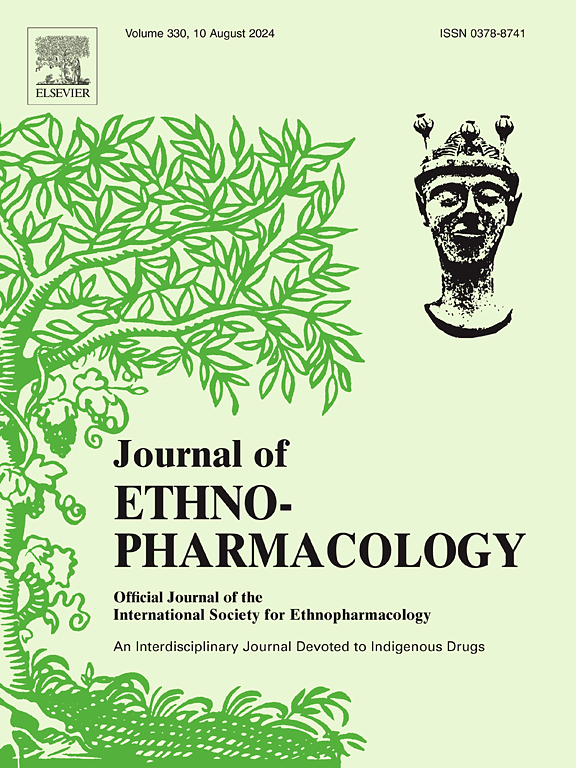Therapeutic effects of Saussurea graminea Dunn and its active compounds in sepsis-associated liver injury: Transcriptomics, metabolomics and experimental validation
IF 4.8
2区 医学
Q1 CHEMISTRY, MEDICINAL
引用次数: 0
Abstract
Ethnopharmacological relevance
Saussurea graminea Dunn (SG), a traditional Chinese medicinal herb known as "Za Chi" in Tibet of China, is frequently utilized in the treatment of inflammatory diseases such as hepatitis. However, the active ingredients and mechanism of its therapeutic effect on Sepsis - associated liver injury (SALI) remain unclear.
Aim of the study
To elucidate the effect of SG in combating SALI, uncover its mechanism of action, and explore possible active compounds.
Materials and methods
We established a SALI model by intraperitoneal injection of lipopolysaccharide to assess the efficacy of SG. Transcriptomics and metabolomics were employed to reveal its possible mechanism of action. Subsequently, Western blot, flow cytometry, confocal microscopy, quantitative PCR, HPLC-MS, and molecular docking were utilized to verify its mechanism and active ingredients.
Results
SG effectively counteracts SALI by inhibiting the cytokine storm. Transcriptomics indicates that SG regulates SALI through mitochondrial/TNF and metabolic pathways. Metabolomics demonstrates that arachidonic acid metabolism is involved in the process of SG treating SALI. HPLC-MS identified the main components of SG as chlorogenic acid, syringin, scopoletin, rutin, isochlorogenic acid, and narcissin, and these six compounds were confirmed as potential active components in the RAW264.7 inflammation model.
Conclusion
SG and its active ingredients play a role in alleviating SALI by reducing the cytokine storm through mtDNA/TNF/arachidonic acid metabolism.
雪莲及其活性化合物对脓毒症相关肝损伤的治疗作用:转录组学、代谢组学和实验验证。
民族药理学相关性:雪莲(Saussurea graminea Dunn, SG)是一种在中国西藏被称为“扎芝”的传统中草药,常用于治疗炎症性疾病,如肝炎。然而,其治疗脓毒症相关性肝损伤(SALI)的有效成分及其作用机制尚不清楚。研究目的:阐明SG抗SALI的作用,揭示其作用机制,探索可能的活性化合物。材料与方法:通过腹腔注射脂多糖建立SALI模型,评价SG对SALI的疗效。利用转录组学和代谢组学研究其可能的作用机制。随后,采用Western blot、流式细胞术、共聚焦显微镜、定量PCR、HPLC-MS、分子对接等方法验证其作用机制和有效成分。结果:SG通过抑制细胞因子风暴有效对抗SALI。转录组学表明,SG通过线粒体/TNF和代谢途径调节SALI。代谢组学表明,花生四烯酸代谢参与了SG治疗SALI的过程。HPLC-MS鉴定出SG的主要成分为绿原酸、紫丁香苷、东莨菪碱、芦丁、异绿原酸和水仙素,这6个化合物在RAW264.7炎症模型中被证实为潜在的活性成分。结论:SG及其有效成分可能通过mtDNA/TNF/花生四烯酸代谢减少细胞因子风暴,从而起到缓解SALI的作用。
本文章由计算机程序翻译,如有差异,请以英文原文为准。
求助全文
约1分钟内获得全文
求助全文
来源期刊

Journal of ethnopharmacology
医学-全科医学与补充医学
CiteScore
10.30
自引率
5.60%
发文量
967
审稿时长
77 days
期刊介绍:
The Journal of Ethnopharmacology is dedicated to the exchange of information and understandings about people''s use of plants, fungi, animals, microorganisms and minerals and their biological and pharmacological effects based on the principles established through international conventions. Early people confronted with illness and disease, discovered a wealth of useful therapeutic agents in the plant and animal kingdoms. The empirical knowledge of these medicinal substances and their toxic potential was passed on by oral tradition and sometimes recorded in herbals and other texts on materia medica. Many valuable drugs of today (e.g., atropine, ephedrine, tubocurarine, digoxin, reserpine) came into use through the study of indigenous remedies. Chemists continue to use plant-derived drugs (e.g., morphine, taxol, physostigmine, quinidine, emetine) as prototypes in their attempts to develop more effective and less toxic medicinals.
 求助内容:
求助内容: 应助结果提醒方式:
应助结果提醒方式:


